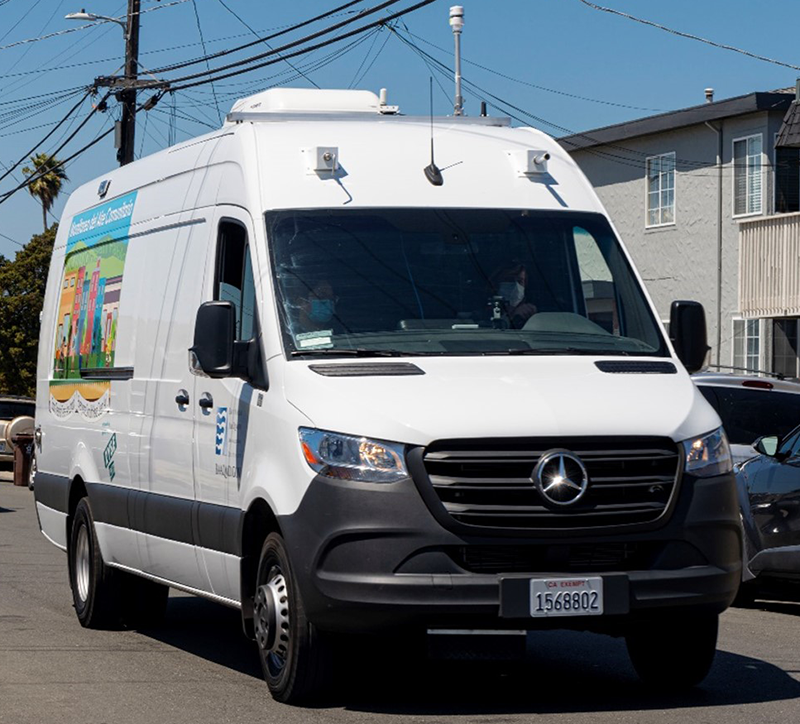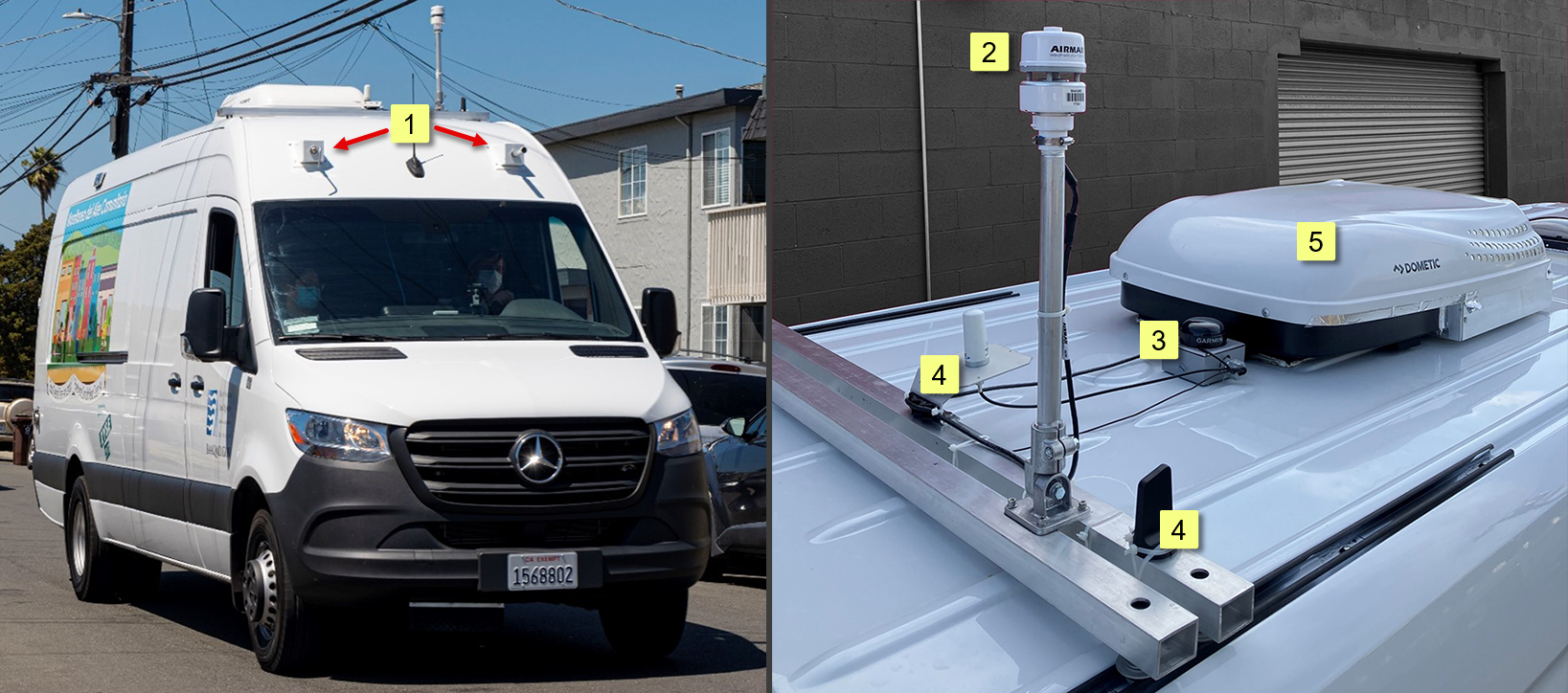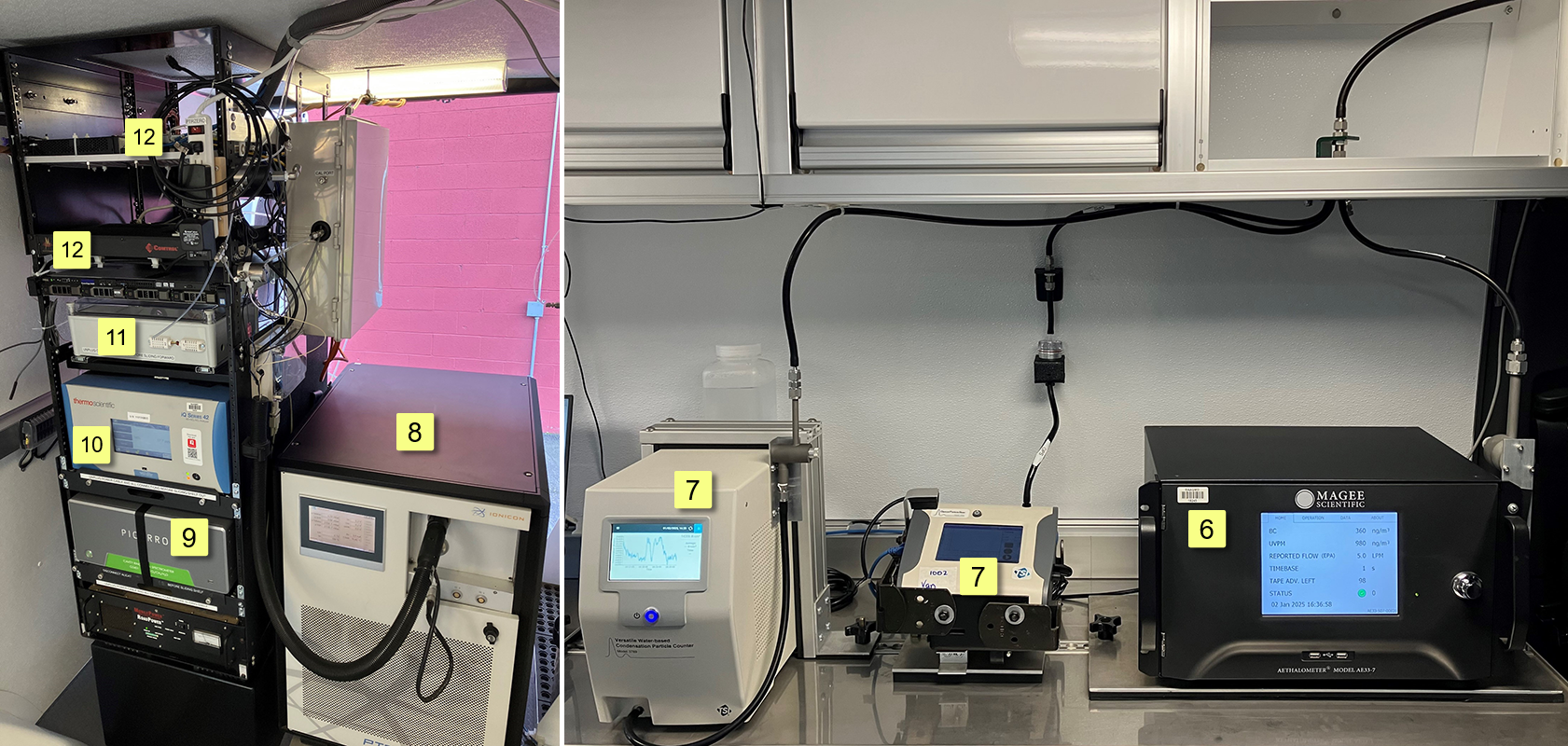Community Air Quality Investigations: Mobile Air Monitoring Van
Learn about the Air District’s mobile air monitoring van for community air quality investigations.

Air District's Community Air Quality Investigations Mobile Air Monitoring Van.
Current projects: East Oakland, Bayview Hunters Point Southeast SF (information coming soon)
Past project: Richmond-North Richmond-San Pablo
The Air District has a specialized air quality monitoring van that collects data on a broad range of pollutants while in motion. We can drive this van directly to communities and neighborhoods to get a closer look at the air that people are breathing. You may see our van driving around your neighborhood throughout the day. The data we collect can be used to describe pollution and sources of pollution that are unique to the community and are not well captured by other types of technical tools or datasets.
Advancing Environmental Justice
Everyone deserves to breathe clean air. Communities of color and other marginalized communities are disproportionally impacted by poor air quality as a result of historical redlining and racist or race-neutral policies of the past. Environmental justice is built upon an intentional collaboration between community groups, local government, and other stakeholders to restore the environmental quality of life in these communities to a healthy state, reducing disparities in air pollution exposure. The Air District’s 2024-2029 Strategic Plan is a roadmap to advance environmental justice. The community mobile air monitoring van is one tool that is being put into action.
Air Monitoring Approach and Understanding Local Air Pollution
The Air District has operated a long-term air monitoring network for over 50 years. This network consists of stationary air monitoring stations at selected locations across the Bay Area. These stations are designed to meet EPA requirements and provide data to compare with health-based air quality standards, inform the public on current air quality, assess long-term pollution trends, evaluate levels of certain pollutants near major sources, such as refineries or heavily trafficked roadways, and provide information for air quality forecasts, among other data uses.
While our stationary air monitoring network helps characterize area-wide pollution levels and may reflect typical exposures throughout a region, it is not representative of the unique mix of air pollution from sources that are common in overburdened communities experiencing environmental injustices. As region-wide air quality has improved, these communities have air pollution issues that persist and remain under-characterized. Learning more about air quality disparities and pollution sources in overburdened communities can help inform efforts to reduce emissions and exposure to air pollution. Taking air quality measurements within the communities that live close to local pollution sources is one important way that we can learn more about these issues.
The need to understand and reduce air pollution on a community-scale has shown that additional air monitoring approaches are also necessary. As technology has improved, air quality monitoring equipment and platforms have advanced to become lightweight, portable, and able to make rapid measurements, allowing them to be installed in vehicles like the community mobile air monitoring van.
Instrumentation and Data
The community mobile air monitoring van is equipped with several harmless, non-intrusive, and advanced air quality instruments that measure the levels of various types of air pollution. This combination of instruments is focused on assessing levels of specific volatile organic compounds (many of which are air toxics) or of particulate matter.
Depending on the specific air quality issues facing a particular community, the type of pollution data we collect can provide a variety of information to help assess potential pollution sources. Since these data are complex and require a high level of quality control and organization, they are not available to the public in real time but are made available for download after data review periodically throughout a project.
The photos below show a closer look at the community mobile air monitoring van and the type of equipment that may be used.
Community Mobile Air Monitoring Van - Exterior

- Sampling Inlets–Air is drawn into the van through specialized ports called sampling inlets. There are two separate inlets, with one connected to gas instruments and another connected to particulate instruments installed in the van. The inlets are designed not to change the composition of the air pollutants coming inside the van, maintaining a representative air sample of the environment the van is driving in.
- Weather Sensor–Wind data collected by the weather sensor can help inform where pollution plumes are coming from.
- GPS–GPS is used to pinpoint the location where our data were recorded.
- Cell Antenna–A cell antenna helps us connect to our van’s data system remotely.
- A/C–An auxiliary A/C system is used to keep the air monitoring equipment and computers from overheating.
Community Mobile Air Monitoring Van - Interior

- Black Carbon–An aethalometer measures black carbon particulate matter, commonly known as “soot.” Black carbon can be found in smoke from burning vegetation (e.g., wildfires) and charcoal, and diesel exhaust (an indicator for diesel particulate matter).
- Particle Size and Count–We use multiple instruments to measure the amount of particles in a large range of sizes relevant to health and source identification. An optical particle sizer and a condensation particle counter are installed in the van, and measure counts for particles 2 nanometers (nm) to 10 micrometers (µm) in size, also allowing us to calculate PM1, PM2.5, and PM10 mass data.
- Air Toxics Hazardous gas-phase air pollutants that can cause severe health effects are known as air toxics, and are typically associated with vehicle exhaust, industrial and chemical manufacturing and refining, and cleaning solvents.
- Carbon Monoxide (CO), Carbon Dioxide (CO2), and Methane (CH4)–These gas-phase pollutants are products of combustion (e.g., power generation, vehicle exhaust, gas appliances, burning vegetation and charcoal) and organic matter decay (e.g., landfills), as well as from natural gas storage and transport.
- Nitrogen Oxides (NOx)–Produced in the combustion process (e.g., power generation, vehicle exhaust, gas appliances), NOx is a combination of two common gas pollutants we encounter daily, nitric oxide (NO) and nitrogen dioxide (NO2), that are important for health and ground-level ozone production.
- Sampling Manifolds and Conditioning–Just like the exterior sampling inlets, interior sampling and conditioning systems are designed so that air pollutants do not change composition or adhere to sampling components before reaching the instruments, causing poor data unrepresentative of the environment the van is driving in.
- Data Logging–We collect air pollution data from all the instruments once every second. These data are stored on a server that allows us to view the data in real-time, perform data quality control, and store data for analysis. We collect thousands of data points each time we drive the van through your community.
For more information on the instrumentation and components described - including manufacturer, model and operational details - see the Air District Mobile Air Monitoring Van Instrumentation document.
For more information about the community air quality investigations mobile air monitoring van and the work we do, see the resources below:
- Community Air Quality Investigations Mobile Air Monitoring Van Brochure

- About the Community Health Protection Program
- About East Oakland work
- About Richmond-North Richmond-San Pablo work and to access the data collected by the Community Air Quality Investigations Mobile Air Monitoring Van
- Air Quality and Health
Last Updated: 7/10/2025

